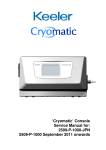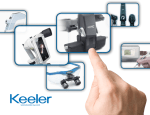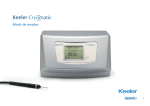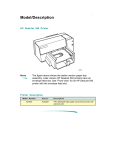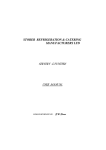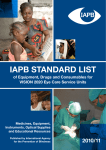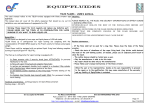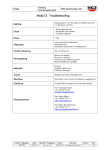Download Service Manual - Keeler Instruments
Transcript
Service Manual Contents Introduction ………………………………………………………………………... About this Manual …………………………………………………………… Scheduled Maintenance ……………………………………………………. Modular Repairs …………………………………………………………….. Other Repairs ……………………………………………………………….. Testing………………………………………………………………………… 4 4 4 4 4 4 Modular Repairs…………………………………………………………………… Replacing the Stem Assembly……………………………………………... Replacing the Hose Assembly……………………………………………... Replacing the Connector Assembly……………………………………….. 5 5 6 7 Blocked Probe……………………………………………………………………… 9 Overview……………………………………………………………………… 9 Repair…………………………………………………………………………. 9 Diagnosis and Repair Tree…………………………………………………. 10 Repairing Leaks and Replacing Filters………………………………………... Overview……………………………………………………………………… Hose Connection leak – coupling………………………………………….. Hose Connection leak – probe…………………………………………….. Replacing Stem Assembly O Rings……………………………………….. Replacing Connector Assembly O Rings and Filters……………………. 11 11 11 12 13 13 Probe Intelligence…………………………………………………………………. 15 Replacing the Chip…………………………………………………………... 15 Reprogramming the Probe…………………………………………………. 15 Spare Parts and Accessories …………………………………………………... 16 Tool List…………………………………………………………………………….. 16 Troubleshooting Guide ………………………………………………………….. 17 Warranty ……………………………………………………………………………. 18 Disposal …………………………………………………………………………….. 18 Technical Data …………………………………………………………………….. 19 Appendix 1 – Probe Assembly Drawing KCP401-B Keeler Probe Service Manual Page 2 of 21 Safety Considerations The system has been designed to comply with the following regulatory standards for Safety and Electromagnetic Compatibility: EN60601-1, UL60601-1 & CAN/CSA-C22.2 No 601.1 EN60601-1-2 Although compliant with applicable EMC directives, this equipment may still be susceptible to excessive emissions and/or may interfere with other more sensitive material. For your own safety and the safety of the equipment, always take the following precautions: Keep the console away from sources of liquids and do not spray with water. Do not use hypercarbonate or phenolic based cleaning solutions or disinfectants containing cationic surfactants (e.g. Dettox) to clean the probe. Ensure that the probe is clean and dry prior to storage. Observe the usual safety precautions, associated with the use of medical gases, at all times. Copies of these guidelines will be available from the gas supplier. Ensure the correct disposition of gas exhausted from the system so as to minimise the exposure to nitrous oxide. This is the responsibility of the user. Ensure that the probe is inspected by properly trained personnel once per annum for performance and safety checks and routine maintenance. Inspect the Cryo Tip for damage before every use. If there is any sign of damage the stem assembly must be replaced. Do not try to straighten a bent Cryo Tip. Do not try to re-shape a Cryo Tip. SAFETY WARNINGS Electrical equipment may be hazardous if misused. The equipment covers should only be removed by authorised technical personnel. Do not use the system in the presence of flammable gases such as anaesthetic agents. KCP401-B Keeler Probe Service Manual Page 3 of 21 1. Introduction About this Manual This manual covers all aspects of servicing the Cryomatic Probe. This manual is for use only by properly trained Keeler service engineers. This manual assumes that the Cryomatic system has been correctly installed following the guidelines in the Cryomatic Operator Manual. Scheduled Maintenance The Cryomatic Probe should be inspected annually by Keeler trained personnel. This service will include: a) b) c) d) Replace the Coupling Filters. Replace the Hose Assembly. Leak test to ITP010. Final test to ITP009. Modular Repairs The probe has been designed in three modular sub assemblies, each can be removed and replaced: a) The Connector Assembly b) The Hose Assembly c) The Stem Assembly Other Repairs In addition to the modular service approach there are several service procedures that require further disassembly: a) b) c) d) e) Unblocking a Probe. Repairing leaks. Replacing the coupling filters. Replacing the probe chip. Reprogramming the probe. Testing Thorough testing following servicing is imperative to ensure maximum safety and performance to: a) ITP010 - Leak Test b) ITP009 - Final Test KCP401-B Keeler Probe Service Manual Page 4 of 21 2. Modular Repairs Replacing the Stem Assembly Remove the Stem Assembly. a) Hold the handle and unscrew the front cap. b) Remove the dowel pin. c) Unscrew the handle from the probe body and pull back to expose the probe body. d) Use a 10mm spanner on the flats of the probe body and tool KCP953 unscrew the stem nut. e) Pull the stem assembly out of the probe body. Fit the Stem Assembly. a) Carefully press the stem assembly into the probe body, taking care not to damage the o-rings. b) Screw the stem nut into the probe body, do not tighten. c) Align the dowel hole and fit the dowel. d) Use a 10mm spanner on the flats of the probe body and tool KC953 to screw the stem nut into the probe body. e) Screw the front cap on to the probe body, whilst ensuring the dowel pin remains in place. Test the Probe. a) Leak test to ITP010. b) Final test to ITP009. KCP401-B Keeler Probe Service Manual Page 5 of 21 Replacing the Hose Assembly Remove the Stem Assembly as described in ‘replacing the stem assembly’ Remove the Coupling Assembly. a) Unscrew the coupling shroud from the coupling body to expose the two hose connections. b) Using 6mm spanner unscrew the retaining screw and pull the connection out of the coupling. c) Discard the hoses. Clean the Coupling ports. a) Visually inspect the hose connector port and remove any visible debris. b) Connect one port to the high pressure hose and gas through to blow out any debris. c) Repeat with both ports. Fit the new Hose Assembly. a) Prior to fitting to the coupling check the hoses are not twisted along the entire length. b) Push the hose connector into the receptacles on the coupling. Ensure the hose marked with black sleeve is fitted to the exhaust port. c) Screw in the retaining screw and tighten using a 6mm spanner. d) Repeat for both hoses. e) Do not screw the coupling shroud in place until the probe has been leak tested to ITP010. Clean the Hoses. a) Connect one port to the high pressure hose and turn on the gas for 1 or 2 seconds to blow out any debris. b) Repeat with both ports. KCP401-B Keeler Probe Service Manual Page 6 of 21 CAUTION: Ensure the hose is held firmly before applying pressure and that it is projected away from yourself or anyone else. Fit the Stem Assembly as described in ‘replacing the stem assembly’ Final Assembly and Test a) Leak test to ITP010. b) Screw the coupling shroud onto the coupling. Firmly grip the outer sleeve to prevent twisting. c) Final test to ITP009. Replacing the Connector Assembly Remove the Coupling Assembly. d) Unscrew the coupling shroud from the coupling body to expose the two hose connections. e) Using 6mm spanner unscrew the retaining screw and pull the connection out of the coupling. Remove and replace the connector assembly. a) Unscrew the two screws securing the connector assembly in the body. b) Remove the connector assembly from the body. c) Push the new connector assembly into the probe body. Ensure the alignment pins fit in the grooves in the probe body. d) Screw in the two screws securing the connector assembly in the body. KCP401-B Keeler Probe Service Manual Page 7 of 21 Clean the Coupling ports. d) Visually inspect the hose connector port and remove any visible debris. e) Connect one port to the high pressure hose and gas through to blow out any debris. f) Repeat with both ports. Fit the Hose Assembly. f) Prior to fitting to the coupling check the hoses are not twisted along the entire length. g) Push the hose connector into the receptacles on the coupling. Ensure the hose marked with black sleeve is fitted to the exhaust port. h) Screw in the retaining screw and tighten using a 6mm spanner. i) Repeat for both hoses. j) Do not screw the coupling shroud in place until the probe has been leak tested to ITP010. Final Assembly and Test d) Leak test to ITP010. e) Screw the coupling shroud onto the coupling. Firmly grip the outer sleeve to prevent twisting. f) Final test to ITP009. KCP401-B Keeler Probe Service Manual Page 8 of 21 3. Blocked Probe Overview On rare occasions the probe may become blocked due to debris or contaminants entering the system. The most likely source of contamination is from industrial grade gas or dirty gas cylinders which may contain particulate matter. Therefore to help minimise the chance of blocking it is important that medical grade gas is used. It is also possible for debris to enter the system during service procedures that break into the gas line. Therefore it is advised to clean the hoses (as detailed in replacing the hose assembly) when these type of service procedures are carried out, even if the probe does not appear to be blocked. Repair There are several places in a Probe where a block can occur as detailed below. However the most common area is the Stem Assembly. a) Stem Assembly b) Hose Connection. c) Coupling Filter. Refer to the fault diagnosis and repair tree to identify and repair the blockage. KCP401-B Keeler Probe Service Manual Page 9 of 21 Diagnosis and Repair Tree Measure Flow Yes Is the flow within specification? No Disconnect both hoses at the coupling end Connect gas to supply port Is the flow ok? Yes No Is the flow ok? No Replace the supply filter and connect to gas Yes Replace the staubli connector Connect gas to exhaust port Is the flow ok? No Yes Yes Replace the exhaust filter and connect to gas Is the flow ok? No Connect the exhaust hose to the supply port. Switch gas on and off several times Repeat 3 times Reconnect hoses correctly and check flow rate Is the flow within specification? No Replace the stem assembly Yes Leak Test to ITP010 Final Test to ITP009 Gas Type (Final Test ITP009) – Medical Grade N2O Gas Type (All other procedures) - Medical Grade N2, CO2, N2O Gas Pressure – 550 to 850 psi. Pack and Ship KCP401-B Keeler Probe Service Manual Page 10 of 21 4. Repairing Leaks and Replacing Filters Overview Potential leak areas include the hose connection, coupling connector and stem assembly o rings. Leaks are most likely to occur following servicing of a probe. It is therefore important to leak test to ITP010 to identify the source of any leaks prior to final testing (ITP009). Hose Connection Leak – Coupling Remove the hose connection. a) Unscrew the coupling shroud from the coupling body to expose the two hose connections. b) Using 6mm spanner unscrew the leaking retaining screw and pull the connection out of the coupling. Clean the coupling ports. a) Visually inspect the hose connector port and remove any visible debris. b) Connect the port to the high pressure hose and gas through to blow out any debris. Fit a new o ring. a) Discard the old o ring. b) Fit a new o-ring. Fit the hose connector. a) Prior to fitting the hose connector ensure the hoses are not twisted along the entire length. b) Push the hose connector into the hose connector port. The exhaust hose is indicated by a small length of black sleeve and must be fitted to the exhaust port. c) Screw in the retaining screw and tighten. Final Assembly and Test a) Leak test to ITP010. b) Screw the coupling shroud onto the coupling. Firmly grip the outer sleeve to prevent twisting. c) Final test to ITP009. KCP401-B Keeler Probe Service Manual Page 11 of 21 Hose Connection Leak – Probe Expose the hose connections a) Hold the probe body (exposed metal ring) and unscrew the handle. If the front cap unscrews first remove the cap to get a better grip on the probe body. If the front cap needs to be removed store the dowel pin as it will be reused. b) Pull back the handle to expose the probe body. Confirm which hose connection is leaking by immersing probe in water whilst pressurised. Disconnect the leaking hose connector. a) Unscrew the retaining screw (17) from the receptacle (supply) using a 5mm spanner on the receptacle and a 6mm spanner on the retaining screw or: b) Unscrew the retaining screw from the probe body (exhaust) using a 10mm spanner on the probe body and a 6mm spanner on the retaining screw. c) Pull the hose connections out of the receptacle. Fit a new o ring. a) Discard the old o ring. b) Visually inspect the hose connection port and remove any debris. c) Fit a new o-ring. Fit the hose connector. a) Prior to fitting the hose connector ensure the hoses are not twisted along the entire length. b) Push the hose connector into the hose connector port. The exhaust hose is indicated by a small length of black sleeve and must be fitted to the exhaust port. c) Screw the retaining screw in and screw in – do not tighten. d) Whilst holding the hose rotate the probe body approximately 90Deg to the right and then tighten. e) Ensure the pip is in the correct orientation and adjust if necessary. KCP401-B Keeler Probe Service Manual Page 12 of 21 Final Assembly and Test a) Leak test to ITP010. b) Screw the handle onto the probe body. Rotate it 5 or 6 times counter clockwise prior to screwing on to allow for the twist of the outer sleeve. c) Final test to ITP009. Replacing Stem Assembly O Rings Remove the Stem Assembly as described in ‘replacing the stem assembly’ Replace the O Rings a) Remove both o rings taking care not to damage the sealing surfaces. A small pair of tweezers may be useful for this. b) Using the large o ring bullet (KCP939) fit a new large o ring. Do not use any lubricant. c) Using the small o ring bullet (KCP938) fit a new small o ring. Do use any lubricant. Fit the Stem Assembly as described in ‘replacing the stem assembly’ Test the Probe. a) Leak test to ITP010. b) Final test to ITP009. Replacing Connector Assembly O Rings and Filters Remove the Connector Assembly a) Unscrew the coupling shroud from the coupling body to expose the two screws. b) Unscrew the two screws securing the connector assembly in the body. c) Remove the coupling body from the connector assembly. KCP401-B Keeler Probe Service Manual Page 13 of 21 Disassemble Connector Assembly a) Using a 13mm and 15mm spanner remove the Staubli connector from the hose connector. Take care to rotate the Stuabli connector and not the hose connector as this will damage the hoses. b) Using a 6mm and 15mm spanner remove the filter holder from the hose connector, taking the same care not to rotate the hose connector. Replace o rings and filter a) Remove and discard the two o rings and fit with new ones. b) Remove and discard the filter and fit a new one. Reassemble Connector Assembly a) Reassemble in the reverse order. b) It may be necessary to loosen the hose connection in order to orientate the Staubli orientation pip. c) Push the connector assembly into the probe body. Ensure the alignment pins fit in the grooves in the probe body. d) Screw in the two screws securing the connector assembly in the body. Final Assembly and Test g) Leak test to ITP010. h) Screw the coupling shroud onto the coupling. Firmly grip the outer sleeve to prevent twisting. i) Final test to ITP009. KCP401-B Keeler Probe Service Manual Page 14 of 21 5. Probe Intelligence Replacing the Probe Chip Remove the chip a) Unscrew the two screws holding the retaining plate in place. b) Remove the retaining plate and chip. Fitting the chip a) Position the new chip in the slot such that the small side of the retaining plate will be positioned along the bottom edge. b) Fit the retaining plate in position. c) Retain in place with the two screws. Reprogramming the Probe To be completed KCP401-B Keeler Probe Service Manual Page 15 of 21 6. Spare Parts and Accessories The following parts are available from the distributor. Item No Description Part Number 1 2 3 4 5 6 7 8 9 10 11 12 13 14 15 16 17 18 19 20 21 22 23 24 25 Connector Assembly Hose Assembly Probe PCB Assembly Standard Retinal Stem Assembly Extended Retinal Stem Assembly Mid Reach Retinal Stem Assembly Glaucoma Stem Assembly Intravitreal Stem Assembly Cataract Stem Assembly Trichiasis Stem Assembly Contact Retainer Coupling Body Staubli Socket M3x6 Pozi C’sk screw s/s M3x10 Pozi C’sk screw s/s S/S Dowel 1mm Dia x 4mm Lg Parallel Stainless Steel Wire 0.25mm 006 Silicone O Ring 606 Silicone O Ring Handle Front Cap Stem Nut Intravitreal Stem Spacer Sintered Filter 1.5 x 1.5 Silicone O ring 0051-16 Silicone O ring KCP052 KCP053 KCP054 KCP201/1 KCP201/2 KCP201/3 KCP201/4 KCP201/5 KCP201/6 KCP201/7 CSP210 CSP211 CST256 FAS039 FAS040 KCP211 KCP212 KCP213 KCP214 KCP301 KCP308 KCP312/2 MCU219 MIS071 Tool List 5mm, 6mm, 10mm, 13mm, 15mm Spanner Medium Pozi Screwdriver Console, mains lead, footswitch, gas and high pressure hose High pressure hose with coupling adaptor Small Blade Screwdriver Small container of water for performance test Tweezers Large container of water for leak testing Small Wire Cutters Stem Nut Tool – KCP953 Small Pliers Small O Ring Bullet – KCP938 Plastic vernier or iceball gauge Large O Ring Bullet – KCP939 Flow Meter KCP401-B Keeler Probe Service Manual Page 16 of 21 7. Troubleshooting Guide The following table provides a troubleshooting guide for the Cryomatic system in the event of minor problems. If the problem is not cleared then the supplier must be contacted for further assistance. Prior to carrying out any service procedure refer to the troubleshooting guide in the user manual to eliminate any possible minor cause. Problem Low Flow Rate High Flow Rate Leak at probe end Leak at coupling end Possible Cause Corrective Action Low freeze pressure. Increase freeze pressure. Refer to diagnosis and repair tree and take appropriate action: - Reverse flush - Replace Stem Assembly - Replace Coupling filter and/or Staubli connector Re-purge the probe. Reduce freeze pressure. Replace stem assembly. Replace Hose Assembly (oring) Debris in probe. Moisture in probe. High freeze pressure. Faulty stem assembly Damaged hose connection oring. Damaged o-ring on the stem assembly. Damaged hose connection oring. Damaged coupling o rings. Damaged probe handle Misuse. Damaged Coupling body Misuse. Console does not recognise probe Coiled spring like hose Orientation pip is misaligned Faulty/Damaged Staubli connector. Faulty chip. Hose has been tightly wound and autoclaved. Incorrect assembly following service. Replace o rings. Replace o-ring. Replace Coupling Assembly (o rings) Replace Hose Assembly. (handle parts) Replace Coupling Assembly (body/shroud) Replace Coupling Assembly (Staubli) Replace Chip. Replace Hose Assembly. Adjust hose position in the handle. *gas cylinders are deemed to be empty when the internal pressure is less than 350 PSI. KCP401-B Keeler Probe Service Manual Page 17 of 21 8. Warranty The Cryomatic and its components are covered by warranty that they meet their performance standards and are free from any defects in materials or workmanship. Within 12 months from delivery by Keeler, the manufacturer shall at no charge to the customer, upon written notice from the customer, repair or replace any components which are defective in material or workmanship. The customer agrees that it shall have no remedy in the event of any breach of the foregoing warranty other than as provided above. This warranty is exclusive and in lieu of all other warranties, expressed or implied, and all implied warranties of merchantability or fitness for a particular purpose are expressly disclaimed. The obligations of the manufacturer as set forth in this warranty are expressly conditioned on the following:(i) No alterations or repairs of any malfunction of the system shall be made to the system except by the manufacturer or his authorized representative, without the prior written approval of the manufacturer or his authorized representative (and in no case will the manufacturer assume responsibility for repairs or alterations made by those other than the manufacturer or his authorized representative). And (ii) The customer shall give notice to the manufacturer or their authorized representative of any malfunction of the system and shall not use the system in any surgical operation after they are aware of any malfunction. (iii) The customer complies with manufacturer’s recommended Preventative Maintenance (see Section 8) and can provide proof of such action. 9. Disposal Ensure that this equipment is disposed of in accordance with local regulations. Please contact the supplier if in doubt. KCP401-B Keeler Probe Service Manual Page 18 of 21 10. Technical Data Cryogenic System Gas Specification: Medical Grade Nitrous Oxide (N2O) or Carbon Dioxide (CO2) in non-syphon cylinders. Operating Pressure Range: 3100 – 5860 kPa (450 – 850 PSI) Maximum Pressure 8275 kPa (1200 PSI) Freeze Control Footswitch (press to freeze, release to defrost) Electrical Ratings Input Voltage Range: Power Rating: Fuses: 110-240Vac (50/60Hz) 100VA T2AH 250V Dimensions Width: Depth: Height: Weight: 305mm (12”) 200mm (8”) 190mm (7.5”) 2.5kg (6lbs) Classification & Safety Standards Complies with: EN60601-1, UL60601-1 & CAN/CSA-C22.2 No 601.1 Equipment Classification: Class 1, Type BF (Applied Part) Mode of operation: Continuous Protection against ingress: Console IPx0 Footswitch IP68 Environmental Conditions Temperature Range Relative Humidity Atmospheric Pressure Storage -20°C to +50°C 10% to 80% 500hPa to 1060hPa Operating +10°C to +40°C 30% to 70% 700hPa to 1060hPa Symbols used on the equipment All symbols used are in accordance with BS EN60417-2:1999 (Graphical Symbols for use on Equipment). BF (Applied Part) Fuse rating Refer to the User Manual Footswitch connection Dangerous voltages present inside the equipment Exhaust connection AC voltage input Gas inlet connection KCP401-B Keeler Probe Service Manual Page 19 of 21 Appendix 1 – Probe Assembly 0088 Keeler Ltd Clewer Hill Road Windsor Berkshire SL4 4AA England Phone +44 (0) 1753 857177 Fax + 44 (0) 1753 827170 www.keeler.co.uk Keeler Instruments Inc. 456 Parkway Lawrence Park Industrial Estate Broomall, PA. 19008 Phone: (610) 353-4350 (800) 523-5620 (Toll Free) www.keelerusa.com This product is manufactured for Keeler by: Cryogenic Technology Ltd Unit 9 Grove Way Mansfield Woodhouse Nottinghamshire NG19 8BW





















